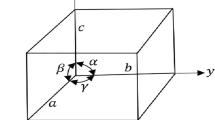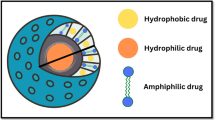ABSTRACT
Purpose
To classify the crystallization behavior of amorphous active pharmaceutical ingredients (API) exposed to aqueous environments.
Methods
A set of approximately 50 chemically and physically diverse active pharmaceutical ingredients (APIs) was selected for this study. Two experimental setups were employed to characterize the crystallization behavior of the amorphous API in an aqueous environment. For the first approach, precipitation, as evidenced by the development of turbidity, was induced using the solvent shift method, by mixing concentrated API solutions in DMSO with an aqueous buffer in a capillary. Subsequently, crystallization was monitored in situ over time using synchrotron radiation (simultaneous SAXS/WAXS beamline 12-ID-B at the Advanced Photon Source, Argonne National Laboratories, Argonne, IL). In the second approach, amorphous films were prepared by melt quenching; after adding buffer, crystallization was monitored with time using polarized light microscopy.
Results
In general, the crystallization behavior of a given compound was similar irrespective of the experimental method employed. However, the crystallization behavior among different compounds varied significantly, ranging from immediate and complete crystallization to no observable crystallization over biorelevant time scales. Comparison of the observed behavior with previous studies of crystallization tendency in non-aqueous environments revealed that the crystallization tendency of individual APIs was somewhat similar regardless of the crystallization environment.
Conclusions
API properties, rather than the method by which amorphous materials are generated, tend to dictate crystallization behavior in aqueous media.






Similar content being viewed by others
REFERENCES
Lipinski CA. Drug-like properties and the causes of poor solubility and poor permeability. J Pharmacol Toxicol Methods. 2000;44(1):235–49.
Millard JW, Alvarez-Núňez FA, Yalkowsky SH. Solubilization by cosolvents—establishing useful constants for the log-linear model. Int J Pharm. 2002;245(1–2):153–66.
Brewster ME, Loftsson T. Cyclodextrins as pharmaceutical solubilizers. Adv Drug Deliv Rev. 2007;59(7):645–66.
Stella VJ, Nti-Addae KW. Prodrug strategies to overcome poor water solubility. Adv Drug Deliv Rev. 2007;59(7):677–94.
Van Eerdenbrugh B, Van den Mooter G, Augustijns P. Top-down production of drug nanocrystals: nanosuspension stabilization, miniaturization and transformation into solid products. Int J Pharm. 2008;364(1):64–75.
Leuner C, Dressman J. Improving drug solubility for oral delivery using solid dispersions. Eur J Pharm Biopharm. 2000;50(1):47–60.
Hancock BC, Parks M. What is the true solubility advantage for amorphous pharmaceuticals? Pharm Res. 2000;17(4):397–404.
Murdande SB, Pikal MJ, Shanker RM, Bogner RH. Solubility advantage of amorphous pharmaceuticals: I. A thermodynamic analysis. J Pharm Sci. 2010;99(3):1254–64.
Murdande SB, Pikal MJ, Shanker RM, Bogner RH. Solubility advantage of amorphous pharmaceuticals: II. Application of quantitative thermodynamic relationships for prediction of solubility enhancement in structurally diverse insoluble pharmaceuticals. Pharm Res. 2010;27(12):2704–14.
Murdande SB, Pikal MJ, Shanker RM, Bogner RH. Solubility advantage of amorphous pharmaceuticals, Part 3: Is maximum solubility advantage attainable and sustainable? J Pharm Sci. 2011;100(10):4349–56.
Hsieh YL, Ilevbare GA, Van Eerdenbrugh B, Box KJ, Sanchez-Felix MV, Taylor LS. pH-Induced precipitation behavior of weakly basic compounds: determination of extent and duration of supersaturation using potentiometric titration and correlation to solid state properties. Pharm Res. 2012;29(10):2738–53.
Ilevbare GA, Taylor LS. Liquid-liquid phase separation in highly supersaturated aqueous solutions of poorly-water soluble drugs—implications for solubility enhancing formulations. Cryst Growth Des. 2013;13(4):1497–509.
Zhou DL, Zhang GGZ, Law D, Grant DJW, Schmitt EA. Physical stability of amorphous pharmaceuticals: importance of configurational thermodynamic quantities and molecular mobility. J Pharm Sci. 2002;91(8):1863–72.
Graeser KA, Patterson JE, Zeitler JA, Gordon KC, Rades T. Correlating thermodynamic and kinetic parameters with amorphous stability. Eur J Pharm Sci. 2009;37(3–4):492–8.
Van Eerdenbrugh B, Taylor LS. Small scale screening to determine the ability of different polymers to inhibit drug crystallization upon rapid solvent evaporation. Mol Pharm. 2010;7(4):1328–37.
Van Eerdenbrugh B, Taylor LS. An ab initio polymer selection methodology to prevent crystallization in amorphous solid dispersions by application of crystal engineering principles. CrystEngComm. 2011;13(20):6171–8.
Baird JA, Van Eerdenbrugh B, Taylor LS. A classification system to assess the crystallization tendency of organic molecules from undercooled melts. J Pharm Sci. 2010;99(9):3787–806.
Van Eerdenbrugh B, Baird JA, Taylor LS. Crystallization tendency of active pharmaceutical ingredients following rapid solvent evaporation—classification and comparison with crystallization tendency from undercooled melts. J Pharm Sci. 2010;99(9):3826–38.
Miyajima M, Koshika A, Okada J, Ikeda M, Nishimura K. Effect of polymer crystallinity on papaverine release from poly (L-lactic acid) matrix. J Control Release. 1997;49(2–3):207–15.
Van Eerdenbrugh B, Stuyven B, Froyen L, Van Humbeeck J, Martens JA, Augustijns P, et al. Downscaling drug nanosuspension production: processing aspects and physicochemical characterization. AAPS PharmSciTech. 2009;10(1):44–53.
Van Eerdenbrugh B, Alonzo DE, Taylor LS. Influence of particle size on the ultraviolet spectrum of particulate-containing solutions: implications for in-situ concentration monitoring using UV/vis fiber-optic probes. Pharm Res. 2011;28(7):1643–52.
Vandecruys R, Peeters J, Verreck G, Brewster ME. Use of a screening method to determine excipients which optimize the extent and stability of supersaturated drug solutions and application of this system to solid formulation design. Int J Pharm. 2007;342(1–2):168–75.
Warren DB, Benameur H, Porter CJH, Pouton CW. Using polymeric precipitation inhibitors to improve the absorption of poorly water-soluble drugs: a mechanistic basis for utility. J Drug Target. 2010;18(10):704–31.
Bevernage J, Forier T, Brouwers J, Tack J, Annaert P, Augustijns P. Excipient-mediated supersaturation stabilization in human intestinal fluids. Mol Pharm. 2011;8(2):564–70.
Alonzo DE, Gao Y, Zhou DL, Mo HP, Zhang GGZ, Taylor LS. Dissolution and precipitation behavior of amorphous solid dispersions. J Pharm Sci. 2011;100(8):3316–31.
Brick MC, Palmer HJ, Whitesides TH. Formation of colloidal dispersions of organic materials in aqueous media by solvent shifting. Langmuir. 2003;19(16):6367–80.
McMahon LE, Timmins P, Williams AC, York P. Characterization of dihydrates prepared from carbamazepine polymorphs. J Pharm Sci. 1996;85(10):1064–9.
Krc J. Crystallographic properties of flufenamic acid. Microscope. 1977;25(1):31–45.
McConnell JF. 3′-Trifluoromethyldiphenylamine-2-carboxylic acid, C14H10F3NO2 flufenamic acid. Cryst Struct Commun. 1973;2:459–61.
Allen FH. The Cambridge structural database: a quarter of a million crystal structures and rising. Acta Crystallogr. 2002;B58:380–8.
Murthy HMK, Bhat TN, Vijayan M. Structural studies of analgesics and their interactions. 9. Structure of a new crystal form of 2-([3-(trifluoromethyl)phenyl]amino)benzoic acid (flufenamic acid). Acta Crystallogr. 1982;B38:315–7.
Chen XM, Li TL, Morris KR, Byrn SR. Crystal packing and chemical reactivity of two polymorphs of flufenamic acid with ammonia. Mol Cryst Liq Cryst. 2002;381:121–31.
Mullin JW. Crystallization. 4th ed. Oxford: Elsiever Butterworth-Heinemann; 2001.
Peeters J, Neeskens P, Tollenaere JP, Van Remoortere P, Brewster ME. Characterization of the interaction of 2-hydroxypropyl-β-cyclodextrin with itraconazole at pH 2, 4, and 7. J Pharm Sci. 2002;91(6):1414–22.
Yalkowsky SH, He Y. Handbook of aqueous solubility data. Boca Raton: CRC Press LLC; 2003.
Alonzo DE, Zhang GGZ, Zhou DL, Gao Y, Taylor LS. Understanding the behavior of amorphous pharmaceutical systems during dissolution. Pharm Res. 2010;27(4):608–18.
Greco K, Bogner R. Solution-mediated phase transformation: significance during dissolution and implications for bioavailability. J Pharm Sci. 2012;101(9):2996–3018.
Baird JA, Thomas LC, Aubuchon SR, Taylor LS. Evaluating the non-isothermal crystallization behavior of organic molecules from the undercooled melt state using rapid heat/cool calorimetry. CrystEngComm. 2013;15(1):111–9.
Mahlin D, Ponnambalam S, Hockerfelt MH, Bergstrom CAS. Toward in silico prediction of glass-forming ability from molecular structure alone: a screening tool in early drug development. Mol Pharm. 2011;8(2):498–506.
Yu L, Reutzel-Edens SM, Mitchell CA. Crystallization and polymorphism of conformationally flexible molecules: problems, patterns, and strategies. Org Process Res Dev. 2000;4(5):396–402.
Hursthouse MB, Huth LS, Threlfall TL. Why do organic compounds crystallise well or badly or ever so slowly? Why is crystallisation nevertheless such a good purification technique? Org Process Res Dev. 2009;13(6):1231–40.
ACKNOWLEDGMENTS AND DISCLOSURES
Use of the Advanced Photon Source was supported by the U. S. Department of Energy, Office of Science, Office of Basic Energy Sciences, under Contract No. DE-AC02- 06CH11357. Dr. Byeongdu Lee and Dr. Xiaobing Zuo (12-ID-B beamline, Advanced Photon Source, Argonne, IL) are acknowledged for their help with the XRPD experiments. B.V.E. is a Postdoctoral Researcher of the “Fonds voor Wetenschappelijk Onderzoek”, Flanders, Belgium. The authors would like to thank the National Science Foundation Engineering Research Center for Structured Organic Particulate Systems for financial support (NSF ERC-SOPS)(EEC-0540855).
Author information
Authors and Affiliations
Corresponding author
Rights and permissions
About this article
Cite this article
Van Eerdenbrugh, B., Raina, S., Hsieh, YL. et al. Classification of the Crystallization Behavior of Amorphous Active Pharmaceutical Ingredients in Aqueous Environments. Pharm Res 31, 969–982 (2014). https://doi.org/10.1007/s11095-013-1216-z
Received:
Accepted:
Published:
Issue Date:
DOI: https://doi.org/10.1007/s11095-013-1216-z




